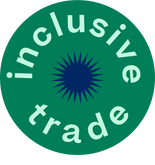Sustainable supply chains
Whether you are sourcing textiles, accessories or finished garments, ensuring a sustainable fashion supply chain from start to end point is a complex process. Building good long-term relationships with suppliers is key to ethical sourcing, and will help to create a transparent and sustainable supply chain.
At inclusive trade our mantra is:
Wouldn't it be great if everything you did and every product or service you bought or created generated a positive impact?
This statement is at the heart of everything we do, and over the years we have developed a sourcing policy that is transparent and logical from start to finish, whether we are sourcing cotton socks from Guatemala or handmade silk scarves from Ethiopia.
We use the UN Sustainable Development goals as our baseline for trade and put them into practice through collaboration, customised solutions and global cooperation, which includes identifying solutions for smaller suppliers from the ground up, rather than adapting existing solutions. We also mentor our suppliers, as we create a sustainable supply process with manufacturers and independent craftsmen across the globe.
If you want to make your sourcing more sustainable, establishing good working relationships with suppliers is essential. These five processes can be incorporated into your sourcing strategy easily and help build long-term partnerships:
1. Do your research
It is important to understand local cultures. Respecting the way that local systems work, understanding local norms and traditions, and making connections with local trade associations and chambers will make it much easier to do business in the long run. Thorough research will also help you to identify suitable suppliers. While there are many established certifications for social and environmental compliance, many factories and suppliers‚ such as individual craftsmen or small manufacturers remain under the radar even though their policies and processes are sustainable.
2. Work with your suppliers as key partners
Inviting your suppliers to be part of the planning process will help them engage with your needs as a customer, as well as understand constraints and work on common solutions‚ making any agreement you reach realistic for both sides.
3. Communicate to create long-term stability
Don't just rely on written communication with your suppliers, speak to them to reduce misunderstandings and the possibility of unpleasant exchanges, and make use of local collaborators who can help you negotiate local norms and ways of doing business. Take the time to assess which forms of communication are possible, and the most effective for the situation‚ for example Viber, WhatsApp, Skype and so on‚ then you can then clarify any issues through written communication.
4. Make your requirements and processes clear, but be flexible
Provide clear requirements to your suppliers in writing, and then discuss which aspects are non-negotiable, and which can be worked on. Collaborate with your suppliers to find solutions, they might have ideas that you haven't thought of, especially relating to social and environmental issues.
5. Learn from your suppliers
Your suppliers have a depth of knowledge and experience about the area they operate in, and working closely with them will help to understand the intrinsic problems they have, and identify local solutions!
